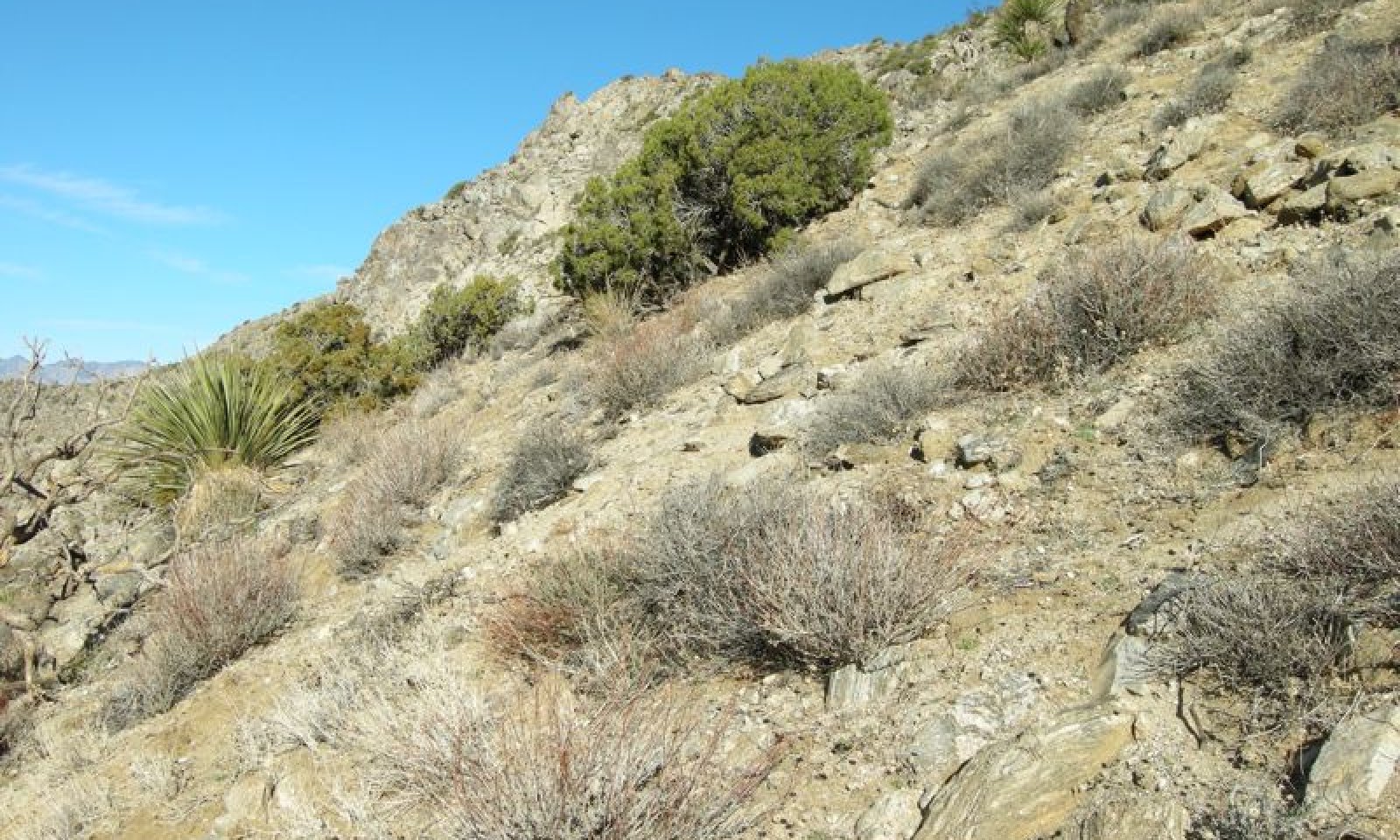
Moderately Deep Gravelly Mountain Slopes
Scenario model
Current ecosystem state
Select a state
Management practices/drivers
Select a transition or restoration pathway
- Transition 1 More details
- Transition 2 More details
- Restoration pathway 1 More details
-
No transition or restoration pathway between the selected states has been described
Target ecosystem state
Select a state
Description
State 1 represents the historic range of variability for this ecological site. This state no longer exists due to the ubiquitous naturalization of non-native species in the Mojave Desert. Periodic drought and very rare fire were the natural disturbances influencing this ecological site.
Historically, stand-replacing fire was probably very rare in this ecological site due to the absence of non-native grasses to fuel fires (Sawyer et al. 2009). When fire did occur, it was probably low severity surface fire that promoted regeneration of short-lived species, but did not cause widespread mortality in California juniper (Sawyer et al. 2009). In the current potential plant community, fires tend to be larger and of moderate to high severity due to the buildup of non-native annual grasses. A recurrence of fire may cause this ecological site to transition to a state dominated by non-native annual grasses.
Data for this State does not exist, but it would have been similar to State 2, except with only native species present. See State 2 narrative for more detailed information.
Description
State 2 represents the current range of variability for this site. Non-native annuals, including red brome and cheatgrass are naturalized in this plant community. Their abundance varies with precipitation, but they are at least sparsely present (as current year's growth or present in the soil seedbank).
Submodel
Description
This state develops when the fire return interval is less than 30 years. This state has been significantly altered from the natural range of variability found in States 1 and 2. California juniper is lost from the plant community. The loss of this deep-rooted species may increase soil erosion on these steep, loose slopes. The seedbank of eastern Mojave buckwheat declines, causing this species to decline in importance. Desert needlegrass may continue to be a dominant species. Non-native annual grasses, native forbs and short-lived perennials dominate this phase.
Submodel
Mechanism
This transition occurred with the naturalization of non-native species in this ecological site. Non-native species were introduced with settlement of the Mojave Desert region in the 1860s.
Mechanism
This transition occurs when the fire return interval is less than 30 years
Mechanism
Restoration of communities severely altered by repeat fire at the landscape scale is extremely difficult, and especially so on the steep, rugged and remote slopes of this ecological site. Methods may include aerial seeding of early native colonizers such as desert needlegrass,sandberg bluegrass, desert globemallow, deervetch, and eastern Mojave buckwheat. Increased native cover may help to reduce non-native plant invasion, helps to stabilize soils, provides a source of food and cover for wildlife, and provides microsites that facilitate California juniper establishment. However, the amount of seed required for success is often prohibitive. Stabilization of soils using mulch or straw is sometimes used on severe burns on steep slopes to prevent soil erosion, but the effectiveness of this is not clear, and in National Park lands, the benefits of introducing foreign material into wilderness have to be carefully weighed with the potential benefits. Large-scale planting of both early colonizers and community dominants tends to be more successful than seeding, especially if outplants receive supplemental watering during the first two years. Pre-emergent herbicides (Plateau) have been used in the year immediately post-fire to attempt to inhibit or reduce brome invasion. How successful this is on a landscape scale, and the non-target effects have not yet been determined.
Model keys
Briefcase
Add ecological sites and Major Land Resource Areas to your briefcase by clicking on the briefcase (![]() ) icon wherever it occurs. Drag and drop items to reorder. Cookies are used to store briefcase items between browsing sessions. Because of this, the number of items that can be added to your briefcase is limited, and briefcase items added on one device and browser cannot be accessed from another device or browser. Users who do not wish to place cookies on their devices should not use the briefcase tool. Briefcase cookies serve no other purpose than described here and are deleted whenever browsing history is cleared.
) icon wherever it occurs. Drag and drop items to reorder. Cookies are used to store briefcase items between browsing sessions. Because of this, the number of items that can be added to your briefcase is limited, and briefcase items added on one device and browser cannot be accessed from another device or browser. Users who do not wish to place cookies on their devices should not use the briefcase tool. Briefcase cookies serve no other purpose than described here and are deleted whenever browsing history is cleared.
Ecological sites
Major Land Resource Areas
The Ecosystem Dynamics Interpretive Tool is an information system framework developed by the USDA-ARS Jornada Experimental Range, USDA Natural Resources Conservation Service, and New Mexico State University.
